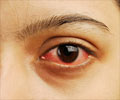In preterm babies, who require treatment to prevent blindness from retinopathy of prematurity (ROP) could be treated with a dose of Avastin (bevacizumab), said researchers.

Avastin is one of several available drugs that inhibit abnormal blood vessel growth by suppressing the overproduction of a signal protein called vascular endothelial growth factor (VEGF).
The U.S. Food and Drug Administration approved Avastin in 2004 as a cancer therapy. Since then, ophthalmologists have used it off-label to inhibit abnormal blood vessel growth in ROP, as well as in other ocular disorders. Results from a clinical trial published in 2011 confirmed the benefit of using Avastin over laser therapy for treating the most severe cases of ROP, which occur in a region of the retina known as posterior zone 1.
"As a faster and easier treatment option, anti-VEGF eye injections were a welcomed alternative to laser therapy for treating severe ROP," said the new study's protocol chair, David Wallace, M.D., MPH, chair of ophthalmology at the Indiana University School of Medicine. Laser therapy requires sedating the baby for as long as 90 minutes; an Avastin injection takes much less time and is generally less stressful to the infant.
"But we know that anti-VEGF agents injected into the eye also get into the bloodstream, and doctors worry that inhibiting VEGF systemically could interfere with normal development of brain, lung, bone, and kidney tissues," he said. Evidence suggests that injections of anti-VEGF in the eye reduce levels of VEGF in the bloodstream.
In this study, Wallace and colleagues in the NEI-funded PEDIG hoped to pinpoint the lowest possible therapeutic dose of Avastin by testing progressively lower doses in 10-14 infants per dose. "We didn't want to start by testing an ineffective dose and risk a child going blind, so we started with 40% of the dose commonly used for ROP. When a dose was successful, we halved it and then tested that dose. Eventually we cut the dose in half seven times," he said.
Advertisement
The study involved 59 preterm infants with type 1 ROP, the most severe form. Each infant had one eye treated by a single injection containing 0.016 mg, 0.008 mg, 0.004 mg, or 0.002 mg of Avastin. If the other eye required treatment, it received twice the concentration (one dose level higher). By comparison, currently used doses of Avastin for ROP range from 0.25 mg to 0.625 mg.
Source-Eurekalert













